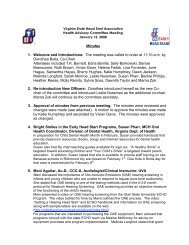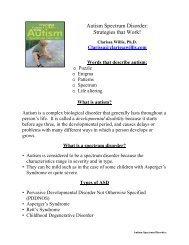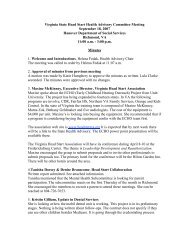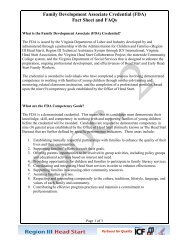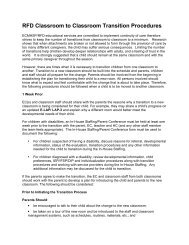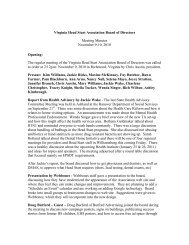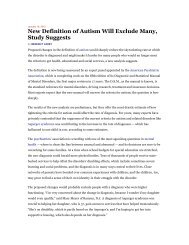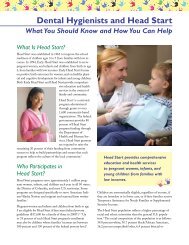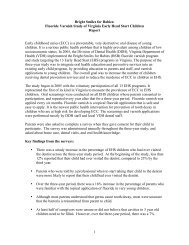What It's Like to Have Autism - Virginia Head Start Association
What It's Like to Have Autism - Virginia Head Start Association
What It's Like to Have Autism - Virginia Head Start Association
Create successful ePaper yourself
Turn your PDF publications into a flip-book with our unique Google optimized e-Paper software.
<strong>What</strong> <strong>It's</strong> <strong>Like</strong> <strong>to</strong> <strong>Have</strong> <strong>Autism</strong><br />
For caregivers, understanding autism symp<strong>to</strong>ms is key <strong>to</strong> coping with them.<br />
One of the most difficult aspects of being a caregiver for someone with autism – whether a child or an adult<br />
– is the inability <strong>to</strong> understand what it’s really like for him. <strong>Autism</strong> is a condition that can be isolating for the<br />
person who has it, and autism symp<strong>to</strong>ms are <strong>to</strong>ugh <strong>to</strong> understand from the outside. Think of autism as a<br />
different way of being. It is a nonstandard way of perceiving and interpreting the environment. Every<br />
person with autism is different, and there is no single autistic perspective. But experts and people who have<br />
the condition say that there are some issues that are shared by many on the autistic spectrum.<br />
According <strong>to</strong> experts, the first key <strong>to</strong> understanding autism is <strong>to</strong> recognize that it profoundly alters how a<br />
person perceives the world. Think of a person with autism as having an imbalanced set of senses. Some<br />
senses may be turned up <strong>to</strong>o high and some turned down <strong>to</strong>o low. As a result, the data that comes in tends<br />
<strong>to</strong> be dis<strong>to</strong>rted, and it’s very hard <strong>to</strong> perceive a person’s environment accurately. People who don’t have<br />
autism are naturally good at filtering out what doesn’t matter. Their senses work <strong>to</strong>gether <strong>to</strong> focus on what’s<br />
relevant. When an average person walks in<strong>to</strong> a roomful of people, he notices who they are and what they<br />
are doing, and figures out how he fits in, but when a person with autism walks in<strong>to</strong> the room, he notices<br />
things that aren’t as relevant – the sound coming from outside the window, a pattern in the carpet, a<br />
flickering light bulb. He’s missing out on the relevant details that would help him understand the situation.<br />
So for him, the world is a lot more confusing.<br />
The second key is <strong>to</strong> understand that people with autism are desperately trying <strong>to</strong> make sense of this<br />
chaos. Experts see many autism symp<strong>to</strong>ms that are difficult for others <strong>to</strong> understand as attempts <strong>to</strong><br />
communicate or <strong>to</strong> assert control over a baffling and disorderly universe. Most of the time, these behaviors<br />
are really an attempt <strong>to</strong> convey something. As a caregiver, the important thing is <strong>to</strong> recognize that and try<br />
<strong>to</strong> figure out what it is.<br />
<strong>What</strong> are some aspects of life that are difficult for people on the autistic spectrum?<br />
Sound. Intense sensitivity <strong>to</strong> sound is a common autism symp<strong>to</strong>m. Loud noises may be painful. The din of<br />
a city street or a mall can be <strong>to</strong>o much. When overwhelmed, people on the autistic spectrum may cover<br />
their ears <strong>to</strong> try <strong>to</strong> block out the noise. They may also start up self-soothing behaviors such as rocking or<br />
shaking their hands. Some people with autism also have central audi<strong>to</strong>ry processing disorder (CAPD), a<br />
condition that makes it difficult for them <strong>to</strong> perceive subtle differences in sound and language.<br />
Touch. Just like sound, physical sensations can be exaggerated and overwhelming <strong>to</strong> people with autism.<br />
Feelings that most people barely register -- the sensation of clothing on the body, a breeze -- can be<br />
unpleasant. Haircuts can be a terrible ordeal. Some people with autism describe the feeling of individual<br />
hairs on their skin as “feeling like needles.”<br />
Communication. Difficulty communicating is a common autism symp<strong>to</strong>m – one of the early signs of the<br />
condition is a delay in speech. But this doesn’t indicate a lack of intelligence. Instead, many children with<br />
autism simply can’t discern how language works. That can be terribly difficult and isolating. There can be<br />
intense frustration associated with being nonverbal and having no ability <strong>to</strong> communicate your needs.<br />
Some people with autism never learn <strong>to</strong> speak. Many simply have a delay in speech skills. Even in those<br />
who master language, communication – real understanding – can still be a problem. One of the hardest<br />
things for many people with autism is expressing or even recognizing how they feel. They’re often really out<br />
of <strong>to</strong>uch with their internal states and feelings. That’s why some who are very bright -- with awe-inspiring<br />
vocabularies -- may still retreat when overwhelmed, engaging in autism symp<strong>to</strong>ms such as repetitive<br />
behaviors instead of explaining what’s bothering them. They’re simply unable <strong>to</strong> articulate it, even internally.<br />
Socialization. People with autism are sometimes pegged as loners who want <strong>to</strong> keep <strong>to</strong> themselves.<br />
There’s this myth that people with autism don’t want <strong>to</strong> socialize. The problem is that they don’t know how<br />
<strong>to</strong> socialize. The unspoken rules of social behavior – things that most other people pick up and use<br />
unconsciously – may remain mysteries <strong>to</strong> people with autism. The result is that socializing, both as a child<br />
and an adult, is difficult and frustrating. It can lead <strong>to</strong> a lot of anxiety. Some people with autism are<br />
forthright <strong>to</strong> a fault A child with autism might walk up <strong>to</strong> a woman and just tell her she’s fat. They<br />
sometimes tell the truth <strong>to</strong>o much. Some children with autism are terrible liars.
Coping Mechanisms People with autism may use behaviors <strong>to</strong> try <strong>to</strong> impose order:<br />
“Stimming.” Short for self-stimula<strong>to</strong>ry behaviors, this includes all sorts of things: flapping hands, echoing<br />
phrases, making noises, and walking in circles. Sometimes, these autism symp<strong>to</strong>ms can be self-injurious,<br />
like head banging. To outsiders, these may seem some of the strangest autism symp<strong>to</strong>ms. They’re really<br />
not so different from all sorts of habits that lots of people have – biting fingernails, fidgeting, or bouncing a<br />
knee. People with autism might have more severe versions of these behaviors. Many with autism<br />
characterize stimming as pleasurable; for some, stimming is a way of coping with a stressful or<br />
overwhelming situation. It can also help them concentrate. Sometimes that repetitive behavior will help a<br />
person with autism <strong>to</strong> block out other noises and activities in a room so they can focus on one thing, like<br />
reading a book.<br />
Compulsive organization. Caregivers are sometimes confused, and awed, by the obsessions and<br />
compulsions that people with autism exhibit. They may obsessively organize things by size or sequence of<br />
colors. They may arrange things “just so” on a daily basis. They may adhere <strong>to</strong> a rigid schedule. If that<br />
schedule is disrupted they may become distraught. For a caregiver, accommodating these needs can be<br />
difficult. A very minor alteration – a single book put upside down on the shelf, a cabinet door left open, an<br />
unexpected day off from school -- can trigger panic. But <strong>to</strong> people with autism, the disruption might feel like<br />
much more than it would <strong>to</strong> you. Seeing that single upside down book might make them feel as if the entire<br />
bookcase had been ransacked and its contents scattered. It’s difficult <strong>to</strong> say exactly what motivates these<br />
obsessions and compulsions. Some believe that these autism symp<strong>to</strong>ms are a reaction against the disorder<br />
they perceive in the world. It can be another attempt <strong>to</strong> bring order and sense <strong>to</strong> an environment that seems<br />
chaotic.<br />
Intellectual obsessions. This is another common autism symp<strong>to</strong>m: an exhaustive and staggering<br />
knowledge of a particular subject. To outsiders, these interests can seem baffling. And when<br />
communication is so difficult already, it can be frustrating when all your loved one wants <strong>to</strong> talk about are<br />
baseball stats or the nuances of the side arms of different Star Wars characters. Again, it’s important <strong>to</strong><br />
understand that these obsessions might serve a function. In a confusing world, a specific interest -- over<br />
which the person with autism has <strong>to</strong>tal mastery -- can be like an anchor, grounding him. And while these<br />
autism symp<strong>to</strong>ms may sometimes be frustrating for a caregiver, they also have a benefit: They offer a way<br />
in. If you have a child with autism who’s obsessed with SpongeBob, then you can learn a lot about<br />
SpongeBob <strong>to</strong>o because that’s how you can talk <strong>to</strong> him. The best thing for a caregiver is <strong>to</strong> find out what a<br />
child’s interests are and <strong>to</strong> start interacting through those interests. When a child is overwhelmed by a<br />
situation, some parents find it helpful <strong>to</strong> talk <strong>to</strong> the child about his favorite subjects. Those efforts <strong>to</strong> connect<br />
with the child on a familiar and comforting <strong>to</strong>pic can help the child <strong>to</strong> calm down.<br />
<strong>Autism</strong> Caregiving: Treatment Caregiving for a loved one with autism can be tremendously difficult. But<br />
happily, treatment can often make a difference. People with autism can learn many of the things that they<br />
don’t know intuitively. It just requires direct instruction. Skills that neurotypical children learn unconsciously<br />
– such as evaluating a social situation or reading a person’s behavior – can be taught, step-by-step. There<br />
are many different approaches <strong>to</strong> instructing children with autism, including the Applied Behavior Analysis<br />
(ABA), the Miller Method, and the Floortime method. There is no single best approach. As a caregiver, the<br />
key is <strong>to</strong> be flexible, <strong>to</strong> try different approaches, and see what works best with your child.<br />
The Importance of the <strong>Autism</strong> Caregiver Caregivers also need <strong>to</strong> understand how important they are.<br />
Experts and individuals with autism give a lot of credit <strong>to</strong> parents for their tenacity and dedication. In the<br />
early 1960s, experts <strong>to</strong>ld many parents of children with severely autistic symp<strong>to</strong>ms that it was hopeless and<br />
they should consider institutionalization. Many parents have defied the experts, kept fighting, and found<br />
success. Successful parents will try <strong>to</strong> accommodate a child’s autism symp<strong>to</strong>ms and keep a home<br />
environment in which he feels safe, all the while working constantly <strong>to</strong> expand his horizons. Some children<br />
with autism would wind up “stagnant” if not for parents encouraging and pushing them <strong>to</strong> experience new<br />
things.<br />
For a caregiver, empathy is key. Just forcing a person with autism in<strong>to</strong> the “real world” won’t work. Instead,<br />
the first step is <strong>to</strong> try <strong>to</strong> understand his perspective a little better. As a parent or caregiver, you need <strong>to</strong> go<br />
in<strong>to</strong> the world of the person with autism first. Then you can start guiding that person out.



